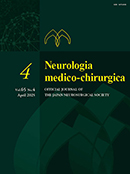
- Issue 4 Pages 161-
- Issue 3 Pages 103-
- Issue 2 Pages 45-
- Issue 1 Pages 1-
- Issue Supplement-1 Pa・・・
- Issue 12 Pages 419-
- Issue 11 Pages 387-
- Issue 10 Pages 353-
- Issue 9 Pages 323-
- Issue 8 Pages 289-
- Issue 7 Pages 253-
- Issue 6 Pages 215-
- Issue 5 Pages 175-
- Issue 4 Pages 137-
- Issue 3 Pages 101-
- Issue 2 Pages 57-
- Issue 1 Pages 1-
- Issue Special-Issue P・・・
- Issue Supplement-3 Pa・・・
- Issue Supplement-2 Pa・・・
- Issue Supplement-1 Pa・・・
- Issue 12 Pages 535-
- Issue 11 Pages 495-
- Issue 10 Pages 437-
- Issue 9 Pages 381-
- Issue 8 Pages 327-
- Issue 7 Pages 265-
- Issue 6 Pages 221-
- Issue 5 Pages 173-
- Issue 4 Pages 131-
- Issue 3 Pages 91-
- Issue 2 Pages 43-
- Issue 1 Pages 1-
- Issue Supplement-3 Pa・・・
- Issue Supplement-2 Pa・・・
- Issue Supplement-1 Pa・・・
- Issue 12 Pages 535-
- Issue 11 Pages 489-
- Issue 10 Pages 445-
- Issue 9 Pages 391-
- Issue 8 Pages 347-
- Issue 7 Pages 307-
- Issue 6 Pages 261-
- Issue 5 Pages 215-
- Issue 4 Pages 165-
- Issue 3 Pages 111-
- Issue 2 Pages 57-
- Issue 1 Pages 1-
- Issue Supplement-3 Pa・・・
- Issue Supplement-2 Pa・・・
- Issue Supplement-1 Pa・・・
- Issue 12 Pages 675-
- Issue 11 Pages 619-
- Issue 10 Pages 563-
- Issue 9 Pages 505-
- Issue 8 Pages 453-
- Issue 7 Pages 393-
- Issue 6 Pages 347-
- Issue 5 Pages 297-
- Issue 4 Pages 245-
- Issue 3 Pages 163-
- Issue 2 Pages 63-
- Issue 1 Pages 1-
- Issue Supplement-3 Pa・・・
- Issue Supplement-2 Pa・・・
- Issue Supplement-1 Pa・・・
- Issue 12 Pages 565-
- Issue 11 Pages 521-
- Issue 10 Pages 483-
- Issue 9 Pages 419-
- Issue 8 Pages 375-
- Issue 7 Pages 319-
- Issue 6 Pages 277-
- Issue 5 Pages 231-
- Issue 4 Pages 165-
- Issue 3 Pages 109-
- Issue 2 Pages 55-
- Issue 1 Pages 1-
- Issue Supplement-3 Pa・・・
- Issue Supplement-2 Pa・・・
- Issue Supplement-1 Pa・・・
- Issue 12 Pages 449-
- Issue 11 Pages 399-
- Issue 10 Pages 361-
- Issue 9 Pages 331-
- Issue 8 Pages 293-
- Issue 7 Pages 247-
- Issue 6 Pages 197-
- Issue 5 Pages 163-
- Issue 4 Pages 117-
- Issue 3 Pages 69-
- Issue 2 Pages 41-
- Issue 1 Pages 1-
- Issue Special-Issue P・・・
- Issue Supplement-3 Pa・・・
- Issue Supplement-2 Pa・・・
- Issue Supplement-1 Pa・・・
- Issue 12 Pages 487-
- Issue 11 Pages 461-
- Issue 10 Pages 405-
- Issue 9 Pages 369-
- Issue 8 Pages 327-
- Issue 7 Pages 279-
- Issue 6 Pages 231-
- Issue 5 Pages 191-
- Issue 4 Pages 147-
- Issue 3 Pages 103-
- Issue 2 Pages 61-
- Issue 1 Pages 1-
- Issue Supplement-3 Pa・・・
- Issue Supplement-2 Pa・・・
- Issue Supplement-1 Pa・・・
- Issue 12 Pages 621-
- Issue 11 Pages 563-
- Issue 10 Pages 505-
- Issue 9 Pages 435-
- Issue 8 Pages 375-
- Issue 7 Pages 301-
- Issue 6 Pages 247-
- Issue 5 Pages 199-
- Issue 4 Pages 151-
- Issue 3 Pages 107-
- Issue 2 Pages 59-
- Issue 1 Pages 1-
- Issue Supplement-3 Pa・・・
- Issue Supplement-2 Pa・・・
- Issue Supplement-1 Pa・・・
- Issue 12 Pages 725-
- Issue 11 Pages 655-
- Issue 10 Pages 585-
- Issue 9 Pages 517-
- Issue 8 Pages 451-
- Issue 7 Pages 355-
- Issue 6 Pages 285-
- Issue 5 Pages 205-
- Issue 4 Pages 151-
- Issue 3 Pages 97-
- Issue 2 Pages 51-
- Issue 1 Pages 1-
- Issue Supplement-3 Pa・・・
- Issue Supplement-2 Pa・・・
- Issue Supplement-1 Pa・・・
- Issue 12 Pages 861-
- Issue 11 Pages 819-
- Issue 10 Pages 775-
- Issue 9 Pages 695-
- Issue 8 Pages 611-
- Issue 7 Pages 529-
- Issue 6 Pages 453-
- Issue 5 Pages 357-
- Issue 4 Pages 267-
- Issue 3 Pages 189-
- Issue 2 Pages 107-
- Issue 1 Pages 1-
- Issue Supplement-3 Pa・・・
- Issue Supplement-2 Pa・・・
- Issue Supplement-1 Pa・・・
- Issue 12 Pages 943-
- Issue 11 Pages 863-
- Issue 10 Pages 775-
- Issue 9 Pages 691-
- Issue 8 Pages 599-
- Issue 7 Pages 511-
- Issue 6 Pages 429-
- Issue 5 Pages 349-
- Issue 4 Pages 261-
- Issue 3 Pages 163-
- Issue 2 Pages 81-
- Issue 1 Pages 1-
- Issue Supplement-3 Pa・・・
- Issue Supplement-2 Pa・・・
- Issue Supplement Page・・・
- |<
- <
- 1
- >
- >|
-
Shigeo YAMASHIRO, Ken UEKAWA, Masatomo KAJI, Toshihiro AMADATSU, Hiroa ...2025 Volume 65 Issue 4 Pages 161-166
Published: April 15, 2025
Released on J-STAGE: April 15, 2025
Advance online publication: February 22, 2025JOURNAL OPEN ACCESSTo clarify the role and reliability of unruptured intracranial aneurysm treatment score in the treatment indications of unruptured intracranial aneurysm for Japanese patients, we performed a retrospective comparative analysis of our actual decision-making and unruptured intracranial aneurysm treatment score judgment. The unruptured intracranial aneurysm treatment score was applied to each of 208 Japanese patients with diagnosis of unruptured intracranial aneurysm for a year. The patients included were classified into 4 groups by integrating actual decisions with the scoring of unruptured intracranial aneurysm treatment score. Of 94 patients treated, unruptured intracranial aneurysm treatment score recommended repair for 64 (68.1%, "appropriately treated") and observation for 5 (5.3%, "possible over-treated"). Among 114 patients under observation, unruptured intracranial aneurysm treatment score recommended repair for 19 (16.7%, "possible under-treated") and observation for 29 (25.4%, "appropriately conservative"). In the remaining 91 patients judged as "not definitive" by the unruptured intracranial aneurysm treatment score, 66 (72.5%) were determined as conservative follow-up. From the perspective of the unruptured intracranial aneurysm treatment score, its sensitivity and specificity were 85.3% and 88.6%, respectively. Our findings suggest that in Japanese patients with unruptured intracranial aneurysm, unruptured intracranial aneurysm treatment score is a reliable tool for guiding treatment decisions for unexpertized clinicians; however, the final judgment should be made by a trained neurosurgeon, especially in cases categorized as not definitive.
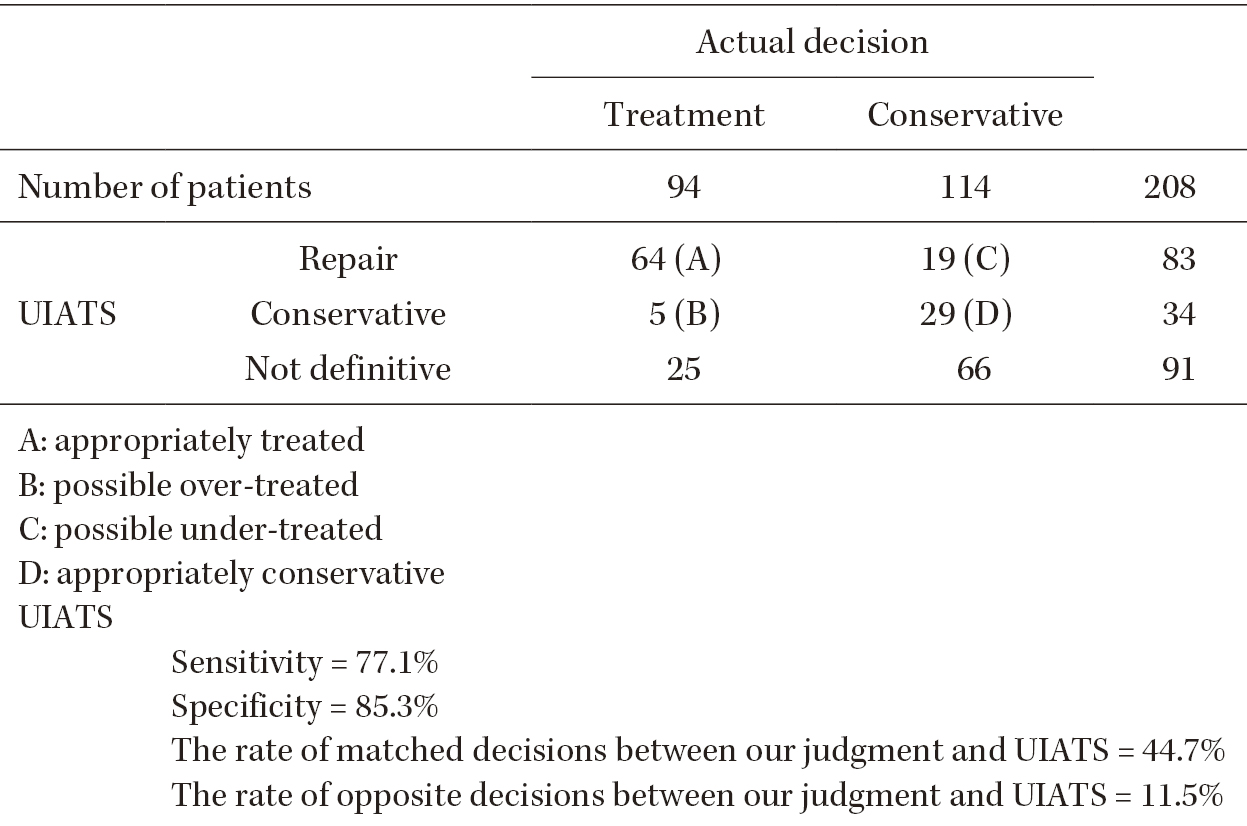 View full abstractDownload PDF (130K)
View full abstractDownload PDF (130K) -
Akiko KAKUTA, Manabu TAMURA, Taiichi SAITO, Shunsuke TSUZUKI, Shunichi ...2025 Volume 65 Issue 4 Pages 167-176
Published: April 15, 2025
Released on J-STAGE: April 15, 2025
Advance online publication: February 10, 2025JOURNAL OPEN ACCESSA unified view on recovery from supplementary motor area syndrome after glioma resection is lacking. This study retrospectively examined the relationship between motor function, higher brain function, the ability to perform activities of daily living, and social reintegration and the extent of tumor resection in patients who underwent resection of tumors near the supplementary motor area. We assigned 24 consecutive patients into 3 groups according to the depth of tumor resection: resection involving (A) only the supplementary motor area (5 patients); (B) the supplementary motor area and cingulate gyrus (11 patients); and (C) the supplementary motor area, cingulate gyrus, and corpus callosum (8 patients). Motor paralysis, language function, and the ability to perform activities of daily living were evaluated perioperatively and 2 months postoperatively, whereas successful social reintegration was examined retrospectively. In group C, 62% of patients developed severe paralysis after surgery, with slow recovery and delayed ambulation (p = 0.0869). Patients with tumors in the left hemisphere, specifically those extending to the cingulate gyrus and corpus callosum, showed decreased scores for postoperative word recall; however, recovery was observed after 2 months. The Functional Instrumental Measure score, which indicates the activity of daily living ability, showed the largest difference preoperatively and postoperatively in group C. The World Health Organization tumor grade (p = 0.0445) and extent of tumor resection (p = 0.0011) were inversely correlated with social reintegration 6 months postoperatively. Overall, the findings suggest that early social reintegration is influenced by the World Health Organization tumor grade (2021 World Health Organization classification) and the extent of tumor resection.
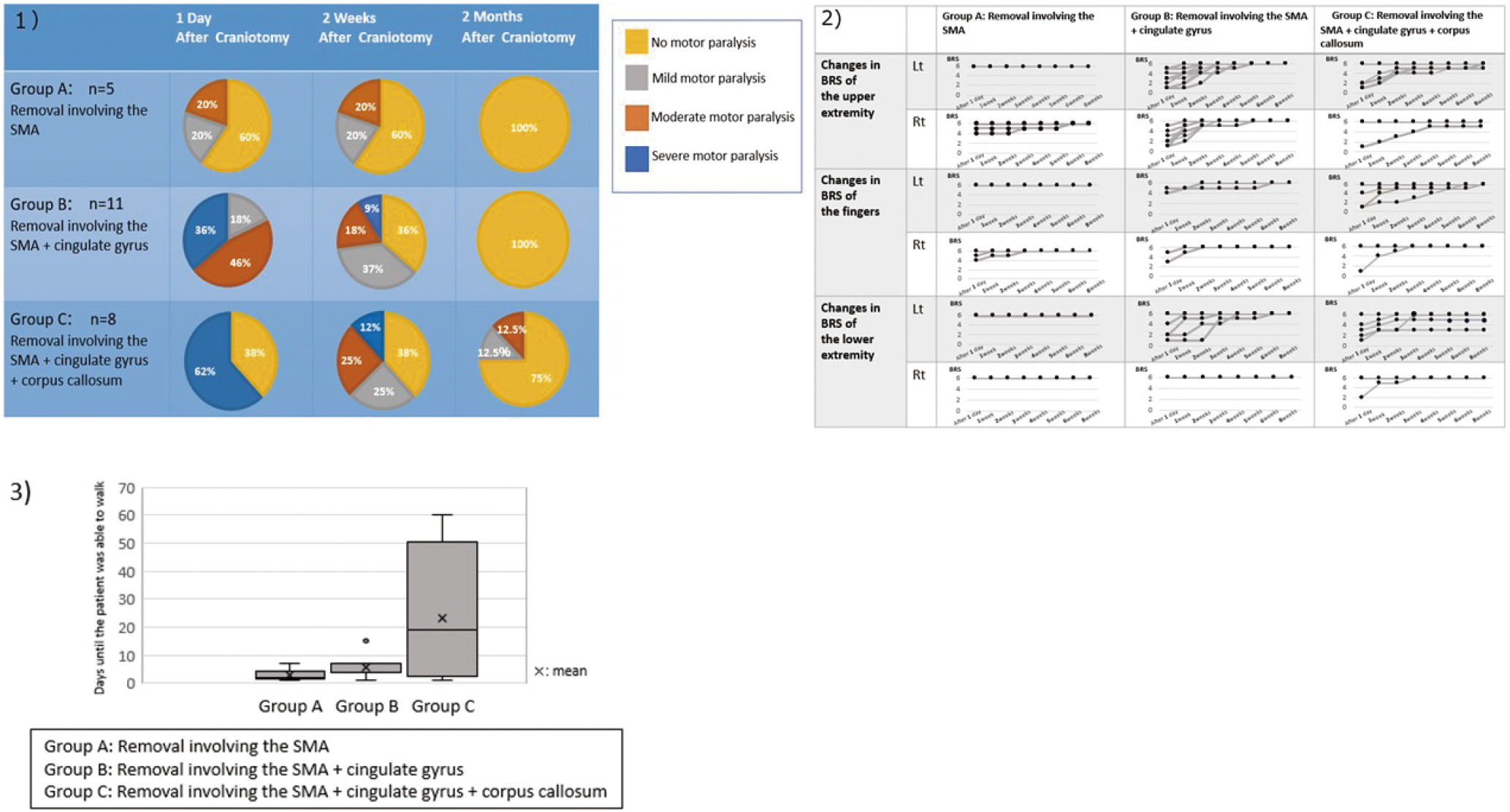 View full abstractDownload PDF (1249K)
View full abstractDownload PDF (1249K) -
Naoki NISHIZAWA, Tomohiko OZAKI, Tomoki KIDANI, Nobuyuki IZUTSU, Shin ...2025 Volume 65 Issue 4 Pages 177-185
Published: April 15, 2025
Released on J-STAGE: April 15, 2025
Advance online publication: February 22, 2025JOURNAL OPEN ACCESS
Supplementary materialThe feasibility of early shunting for hydrocephalus after the occurrence of subarachnoid hemorrhage has not yet been explored. We investigated factors associated with the development of hydrocephalus and the risk of shunt obstruction or infection in patients undergoing early shunt surgery. All cases of hydrocephalus after subarachnoid hemorrhage managed at our institution between January 2010 and December 2020 were included. Patients were classified based on the timing of shunt implantation after hemorrhage onset into either the early shunt group (≤28 days) or the late shunt group (>28 days). Of 138 subarachnoid hemorrhage patients managed during the recruitment period, 53 underwent shunt surgery, with 15 in the early shunt group and 38 in the late shunt group. The severity of subarachnoid hemorrhage, presence of Sylvian hematoma, and placement of an external ventricular and/or cisternal drain were significantly associated with the development of hydrocephalus. There was no significant difference between the early and late groups in terms of the rate of shunt obstruction or infection. In the early group, preoperative cerebrospinal fluid cell count was significantly higher in those who developed obstruction than those who did not (307.3 ± 238.2/3 μL vs. 73.8 ± 95.7/3 μL; p = 0.0364). This retrospective study showed no significant difference between early and late shunt implantation in the rate of shunt obstruction and infection. These findings suggests that planning shunt surgery in the early phase after subarachnoid hemorrhage might be feasible, depending on cerebrospinal fluid test results.
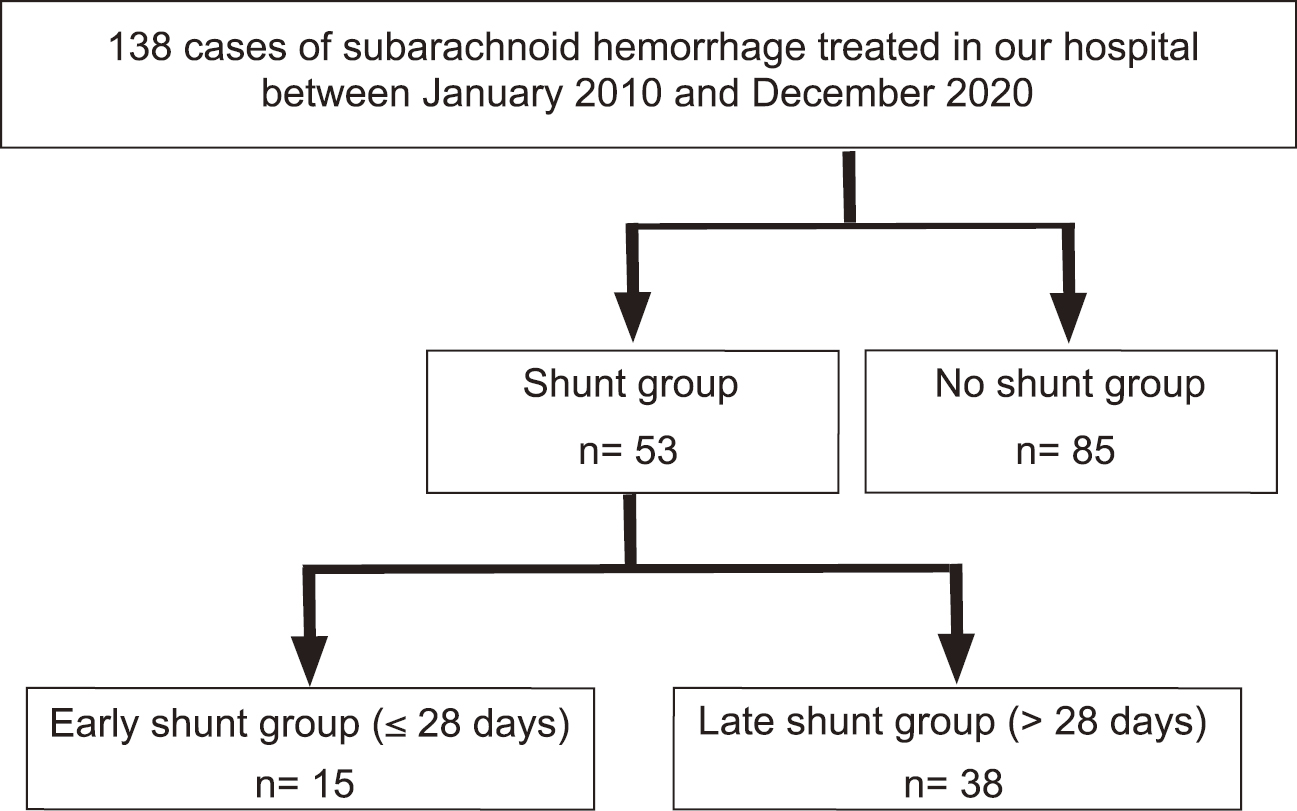 View full abstractDownload PDF (159K)
View full abstractDownload PDF (159K) -
Fuminori SHIMIZU, Kazutaka UCHIDA, Hiroto KAKITA, Sou SAWAMURA, Akihir ...2025 Volume 65 Issue 4 Pages 186-194
Published: April 15, 2025
Released on J-STAGE: April 15, 2025
Advance online publication: February 22, 2025JOURNAL OPEN ACCESSThe effectiveness of endovascular therapy for patients aged 90 years and over (≥90 years) is still not well understood. We compared the patients aged ≥90 years with those aged 85-89 years, 80-84 years, and <80 years using data from the Japanese Registry of NeuroEndovascular Therapy that enrolled acute large vessel occlusion patients from January 2015 to December 2019. The primary outcome was the rate of return of the modified Rankin Scale to at least the premorbid modified Rankin Scale after 30 days. Secondary outcomes were the incidences of intracranial hemorrhage and mortality.Among 13,540 patients, patients aged ≥90 years, 85-89 years, 80-84 years, and <80 years were 1,104, 1,925, 2,477, and 8,034. The prevalence of female gender, the premorbid Rankin Scale, and the National Institutes of Health Stroke Scale score before endovascular therapy were highest in the patients aged ≥90 years (n [%], 819 [74.2]; median [interquartile range]; 2 [0-3], and 21 [15-26]). The primary outcome of the adjusted odds ratio (95% confidence intervals) for the patients aged 85-89 years, 80-84 years, and <80 years for ≥90 years was 0.89 (0.72-1.10), 0.95 (0.77-1.16) and 1.07 (0.89-1.28). However, the incidence of symptomatic intracranial hemorrhage was lower in patients aged ≥90 years compared with patients aged 85-89 years and <80 years (adjusted odds ratio [95% confidence intervals]; 1.86 [1.16-2.98] and 1.71 [1.11-2.64]). The return of the modified Rankin Scale to at least the premorbid modified Rankin Scale after 30 days in patients aged ≥90 years with large vessel occlusion was not significantly different in other groups but symptomatic intracranial hemorrhage was less observed than in younger patients.
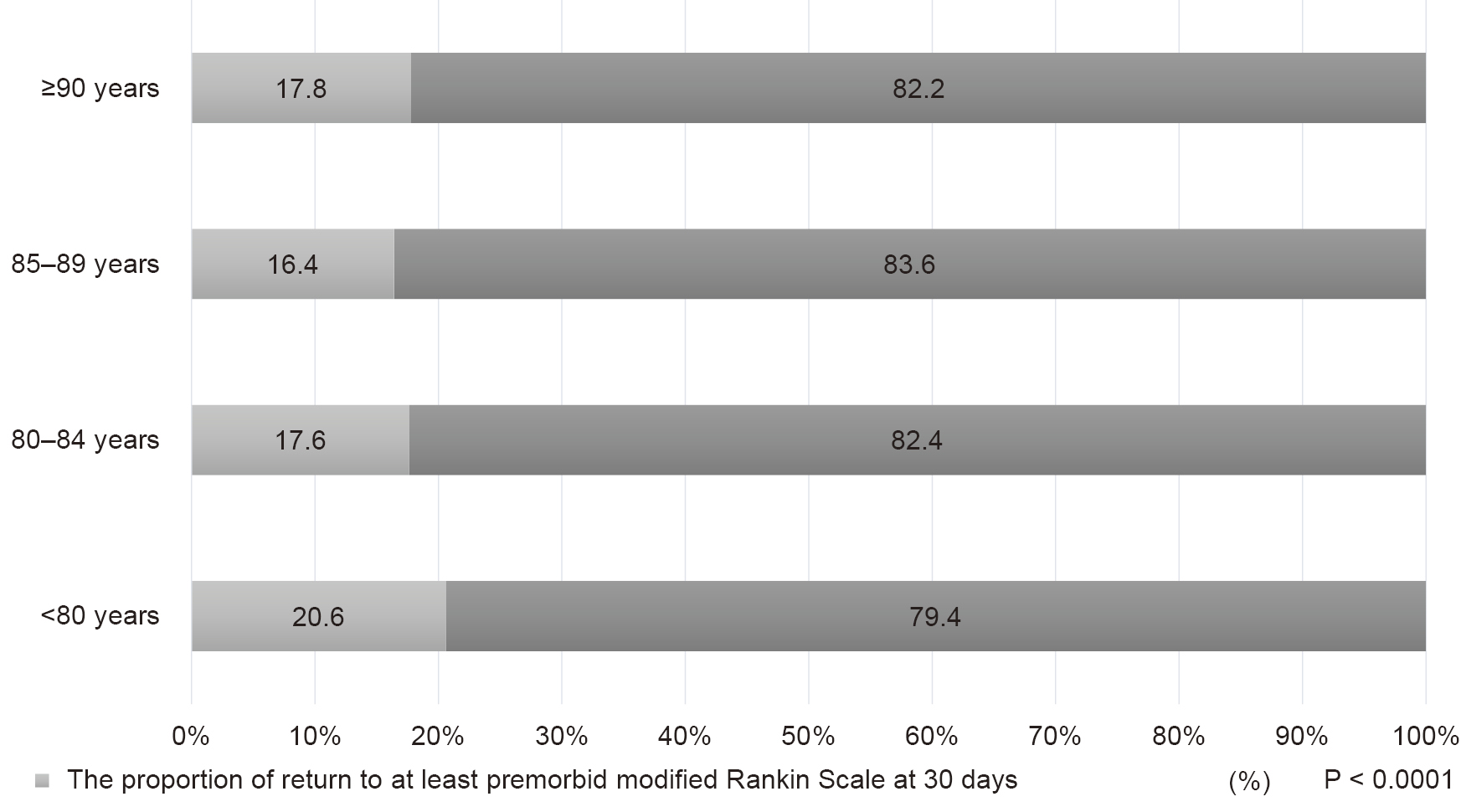 View full abstractDownload PDF (149K)
View full abstractDownload PDF (149K) -
Kenji YAGI, Yasukazu HIJIKATA, Yoshifumi TAO, Yoshihiro SUNADA, Ryunos ...2025 Volume 65 Issue 4 Pages 195-202
Published: April 15, 2025
Released on J-STAGE: April 15, 2025
Advance online publication: March 21, 2025JOURNAL OPEN ACCESSBilateral chronic subdural hematoma is treated by burr-hole surgery. Patients may undergo simultaneous bilateral surgery, or unilateral surgery which occasionally necessitates subsequent contralateral surgery due to the contralateral chronic subdural hematoma progression. Contralateral chronic subdural hematoma progression is not well understood, and an optimal surgical strategy for bilateral chronic subdural hematoma remains undefined. This study aimed to identify predictors for contralateral chronic subdural hematoma progression following unilateral surgery in patients with bilateral chronic subdural hematoma, specifically examining contralateral chronic subdural hematoma presented as membranous (indicating an older hematoma) and the contralateral hematoma volume. In this prospective observational study, 39 patients with bilateral chronic subdural hematoma requiring surgery were included between February 2020 and July 2024. All patients initially underwent unilateral burr-hole surgery. Additional surgery was performed if contralateral chronic subdural hematoma progression occurred. The preoperative predictors of contralateral chronic subdural hematoma progression were investigated. Among the 39 patients, 16 (41%) experienced contralateral chronic subdural hematoma progression, necessitating contralateral surgery. Of the 12 patients with membranous-type chronic subdural hematoma on the contralateral side, contralateral chronic subdural hematoma progression developed in one patient (8%), whereas 15 (56%) of the 27 patients with non-membranous type had contralateral chronic subdural hematoma progression. Logistic regression analyses revealed that membranous-type hematoma was negatively associated with the risk of contralateral chronic subdural hematoma progression, with an odds ratio of 0.07 (95% confidence interval: 0.01-0.65). Additionally, preoperative hematoma volume on the contralateral side was identified as a risk factor for contralateral chronic subdural hematoma progression, with an odds ratio of 1.58 (95% confidence interval: 1.04-2.40) per 10 mL increase. The membranous type and small volume of contralateral chronic subdural hematoma were associated with a lower risk of contralateral chronic subdural hematoma progression after unilateral surgery in bilateral chronic subdural hematoma. We suggest applying unilateral surgery selectively to bilateral chronic subdural hematoma with these characteristics.
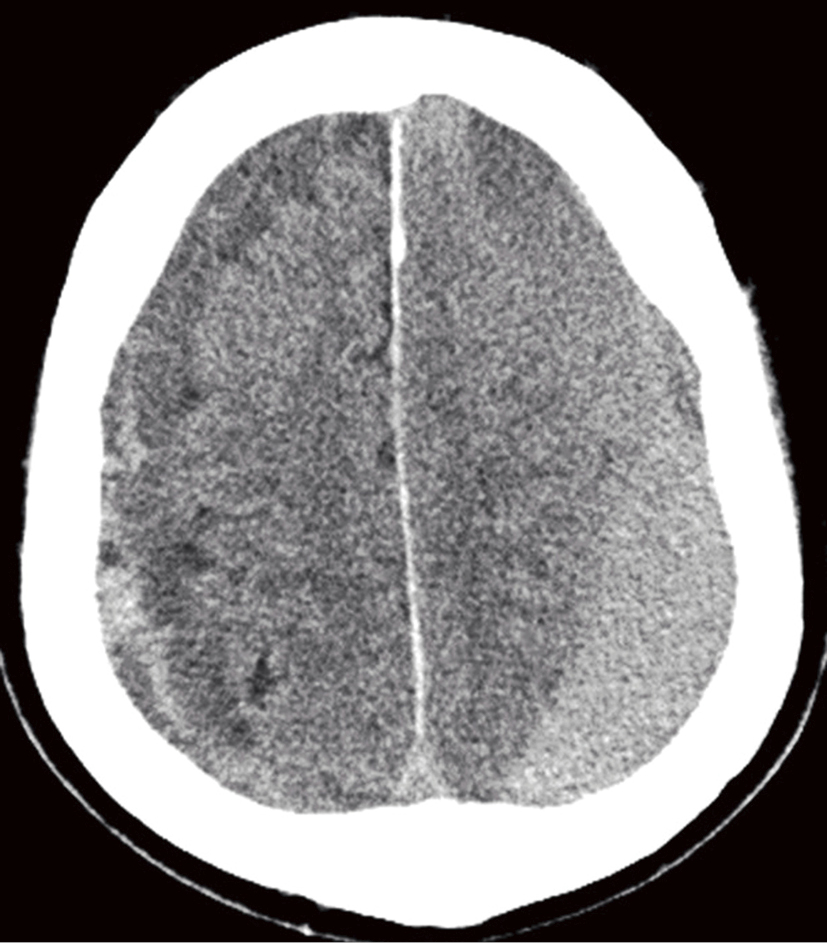 View full abstractDownload PDF (249K)
View full abstractDownload PDF (249K) -
Questionnaire Survey on the Current Use of Brain Docks and Their Compliance with Guidelines in JapanHiroshi KONDO, Fusao IKAWA, Takeshi HARA, Masashi KUWABARA, Daizo ISHI ...2025 Volume 65 Issue 4 Pages 203-210
Published: April 15, 2025
Released on J-STAGE: April 15, 2025
Advance online publication: March 21, 2025JOURNAL OPEN ACCESS
Supplementary materialBrain dock is used for the early diagnosis of intracranial lesions, prevention of cerebrovascular disorders, and early detection of cognitive decline. However, its application varies per facility. This study evaluated the use of brain dock and compliance with its guidelines via a questionnaire survey on the members of the Japan Society of Ningen Dock and Preventive Medical Care and the Japan Brain Dock Society. The questionnaire included information on the respondents, facility characteristics, and brain dock implementation. The number of responses was 288 (response rate: 10.3%). Brain dock was predominantly used in combination with other diagnostic methods. In addition to magnetic resonance imaging, the other examinations performed included the assessment of stroke risk factors and dementia. Radiographic image interpretation was frequently performed by more than one person, often by a neurosurgeon or radiologist. Artificial intelligence was used less frequently. In several facilities, the results were explained to all patients in person and to those who requested the findings in other facilities. Meanwhile, 10% of centers sent the results to the patients. Neurosurgeons were the most common professionals who provided explanations to the patients, followed by outpatient physicians who used the interpretation result as a reference. Only 24% of professionals were aware of the brain dock certification program. By solving the related problems, brain docks can play a greater role in improving medical issues in Japan, where the aging society is projected to increase.
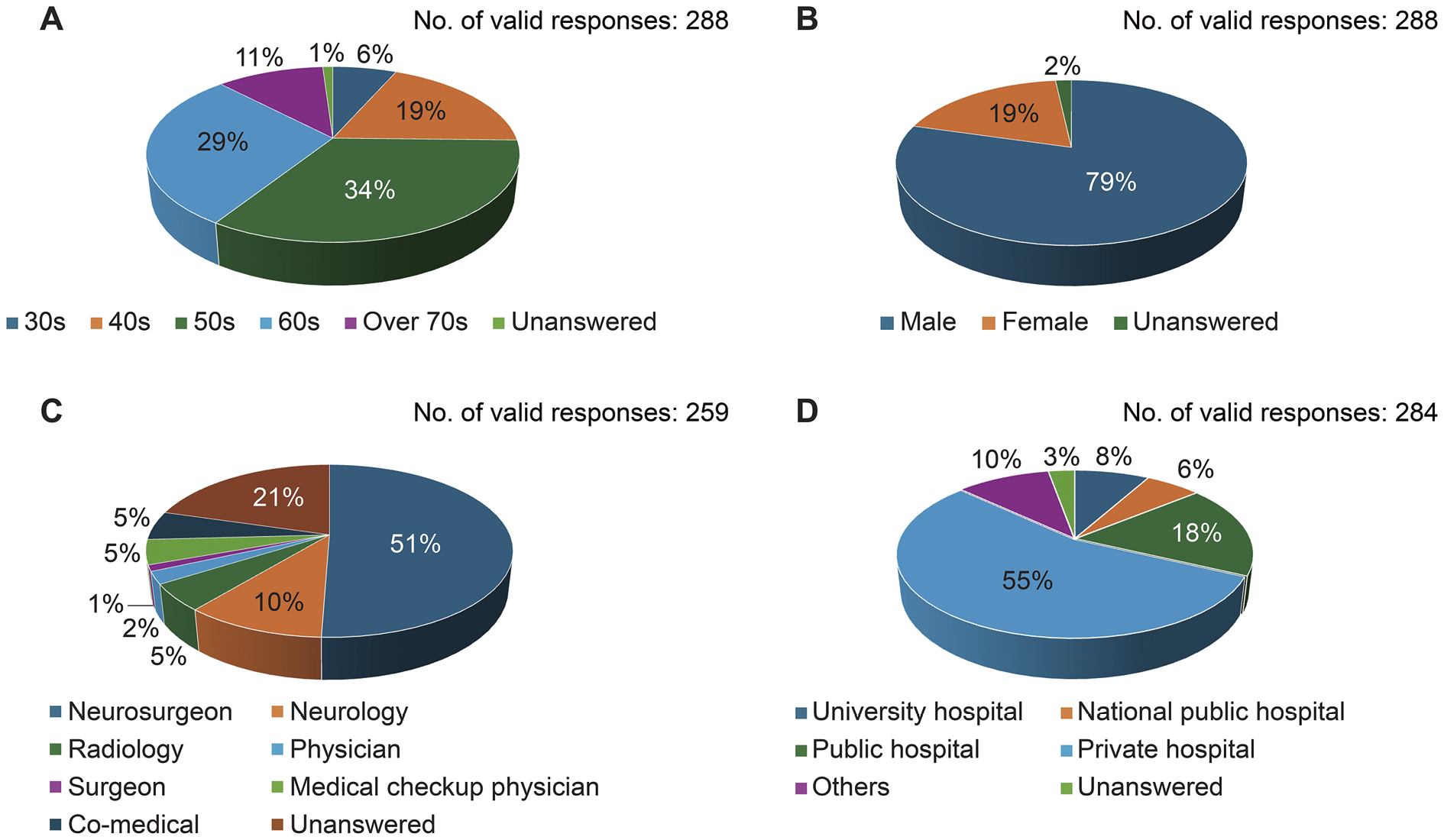 View full abstractDownload PDF (896K)
View full abstractDownload PDF (896K) -
Yuma HIRATSUKA, Takeo MURAHASHI, Yusuke NAKAGAKI, Yoichi NAKAGAKI, Hir ...2025 Volume 65 Issue 4 Pages 211-216
Published: April 15, 2025
Released on J-STAGE: April 15, 2025
Advance online publication: March 21, 2025JOURNAL OPEN ACCESSTwisted carotid bifurcation, a condition in which the internal carotid artery is positioned medially to the external carotid artery at the carotid bifurcation, is one of the anatomical variations encountered during carotid endarterectomy. Although previous studies have suggested that carotid endarterectomy can be performed safely in twisted carotid bifurcation cases, few have focused on postoperative neurological complications. Therefore, this study aimed to evaluate postoperative neurological complications in carotid endarterectomy cases with twisted carotid bifurcation. This study included patients who underwent carotid endarterectomy at Takikawa Neurosurgical Hospital between January 2012 and July 2024. Twisted carotid bifurcation was diagnosed using preoperative computed tomography angiography images. In twisted carotid bifurcation cases, the internal carotid artery was rotated laterally toward the external carotid artery before endarterectomy. Postoperative complications were compared between the twisted carotid bifurcation group and the normal anatomy group. Of the 143 patients who underwent carotid endarterectomy procedures, 31 cases (20.3%) were diagnosed with twisted carotid bifurcation. The incidence of postoperative hoarseness was significantly higher in the twisted carotid bifurcation group (25.8%) compared with the normal anatomy group (8.2%) (p = 0.012). All cases of hoarseness were transient and resolved by the first outpatient follow-up visit after discharge. There were no differences between the 2 groups in the incidence of other postoperative complications. Patients with twisted carotid bifurcation undergoing carotid endarterectomy have a higher risk of postoperative hoarseness compared with those with normal anatomy. However, the hoarseness was transient, and there were no differences in other postoperative complications. With detailed preoperative planning and careful surgical technique, carotid endarterectomy can be performed safely in patients with twisted carotid bifurcation.
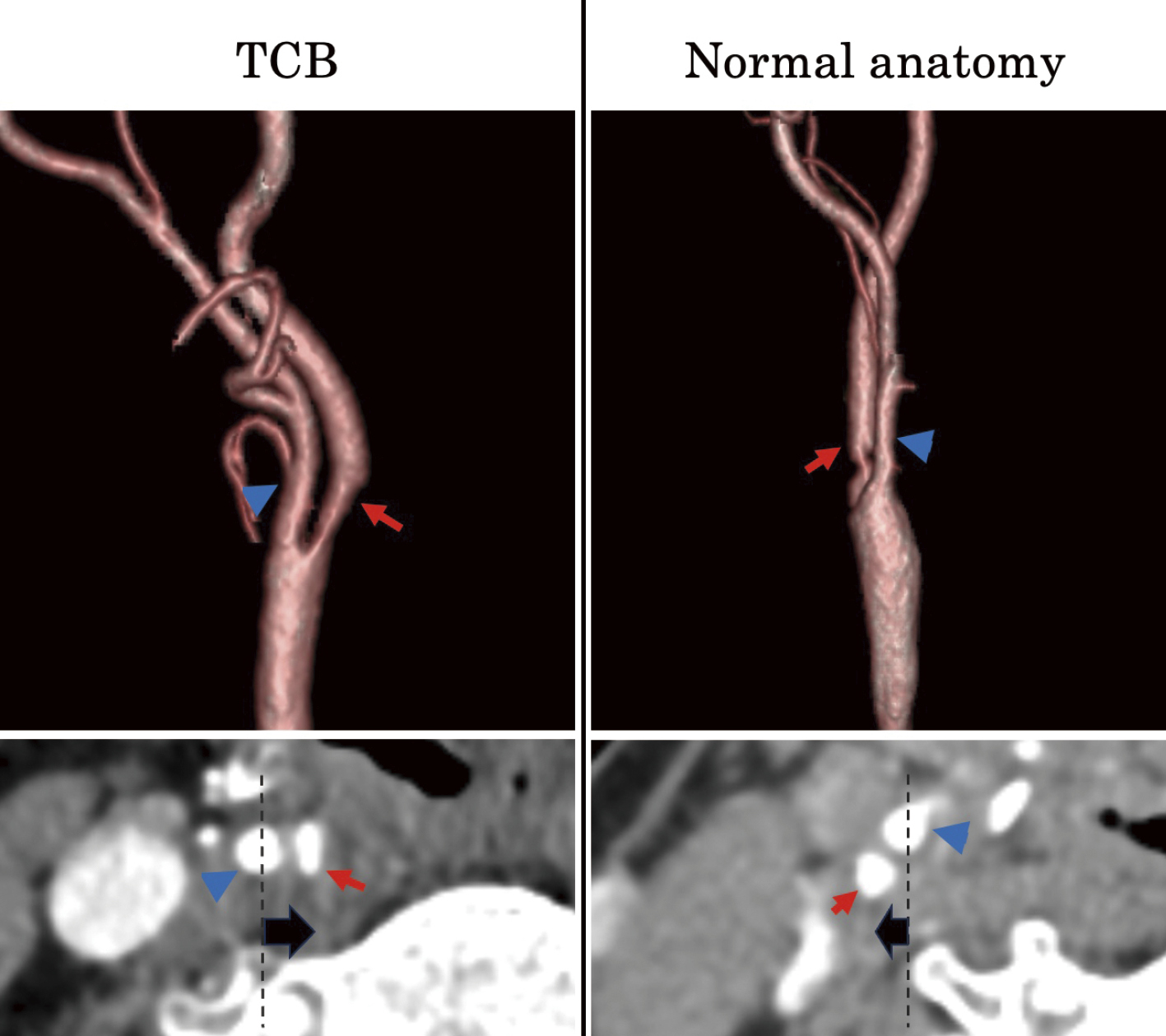 View full abstractDownload PDF (776K)
View full abstractDownload PDF (776K)
-
2025 Volume 65 Issue 4 Pages EC7-EC8
Published: April 15, 2025
Released on J-STAGE: April 15, 2025
JOURNAL OPEN ACCESSDownload PDF (54K)
- |<
- <
- 1
- >
- >|